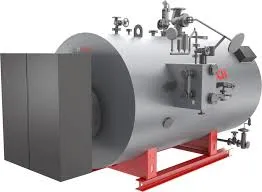
Fév . 15, 2025 17:38 Back to list
Biomass fired steam boiler
An industrial steam system is one of the foundational elements in numerous manufacturing and processing industries. As an essential utility, it powers a myriad of machinery and processes, ensuring efficiency and productivity across the board. Understanding the intricacies of these systems can provide industries with significant cost reductions, enhanced operational efficiency, and increased reliability.
The implementation of digital and smart solutions is transforming how industrial steam systems are managed. IoT-enabled analytics provide valuable insights into system performance, enabling predictive maintenance and minimizing downtime. By leveraging these technologies, industries can identify potential issues before they escalate, allowing for proactive problem-solving and efficient resource management. Safety cannot be overlooked when discussing steam systems. The high pressures and temperatures involved necessitate stringent safety protocols. Regular safety inspections and compliance with international standards are paramount to ensuring safe operations. Trained personnel are indispensable in managing these systems, as they require expertise to navigate the complexities involved and prevent accidents. Environmental sustainability has also become an integral consideration in the design and operation of industrial steam systems. By utilizing cleaner energy sources, such as natural gas and waste-to-energy technologies, industries can significantly reduce their carbon footprint. Moreover, energy-efficient design and operation contribute not only to a cleaner environment but also result in lower operational costs. In conclusion, the industrial steam system remains an indispensable component of modern manufacturing and processing industries. Its effective management requires a blend of technical expertise, ongoing maintenance, and advanced technology integration. By focusing on these critical areas, industries can maximize efficiency, ensure safety, and embrace sustainability, ultimately achieving a competitive edge in their respective markets. While the fundamental principles of steam systems have remained consistent, the innovations and improvements in their components and management strategies continue to evolve, reflecting their indispensable role in industrial productivity.


The implementation of digital and smart solutions is transforming how industrial steam systems are managed. IoT-enabled analytics provide valuable insights into system performance, enabling predictive maintenance and minimizing downtime. By leveraging these technologies, industries can identify potential issues before they escalate, allowing for proactive problem-solving and efficient resource management. Safety cannot be overlooked when discussing steam systems. The high pressures and temperatures involved necessitate stringent safety protocols. Regular safety inspections and compliance with international standards are paramount to ensuring safe operations. Trained personnel are indispensable in managing these systems, as they require expertise to navigate the complexities involved and prevent accidents. Environmental sustainability has also become an integral consideration in the design and operation of industrial steam systems. By utilizing cleaner energy sources, such as natural gas and waste-to-energy technologies, industries can significantly reduce their carbon footprint. Moreover, energy-efficient design and operation contribute not only to a cleaner environment but also result in lower operational costs. In conclusion, the industrial steam system remains an indispensable component of modern manufacturing and processing industries. Its effective management requires a blend of technical expertise, ongoing maintenance, and advanced technology integration. By focusing on these critical areas, industries can maximize efficiency, ensure safety, and embrace sustainability, ultimately achieving a competitive edge in their respective markets. While the fundamental principles of steam systems have remained consistent, the innovations and improvements in their components and management strategies continue to evolve, reflecting their indispensable role in industrial productivity.
Share
Latest News
-
Efficient Gas Fired Thermal Oil Boiler | High-Performance
NewsAug.05,2025
-
Commercial Oil Fired Steam Boilers with GPT-4 Turbo AI
NewsAug.04,2025
-
Coal Fired Thermal Oil Boiler with GPT-4 Turbo Efficiency
NewsAug.03,2025
-
Commercial Steam Boilers for Sale - AI Optimized Efficiency
NewsAug.02,2025
-
Efficient Biomass Fired Hot Water Boiler | AI Heating Solution
NewsAug.01,2025
-
High-Efficiency Gas Thermal Oil Boilers | HPT Models
NewsJul.31,2025
Related PRODUCTS
Copyright © 2025 HEBEI HONGZE BOILER MANUFACTURING CO., LTD. All Rights Reserved. Sitemap | Privacy Policy






















